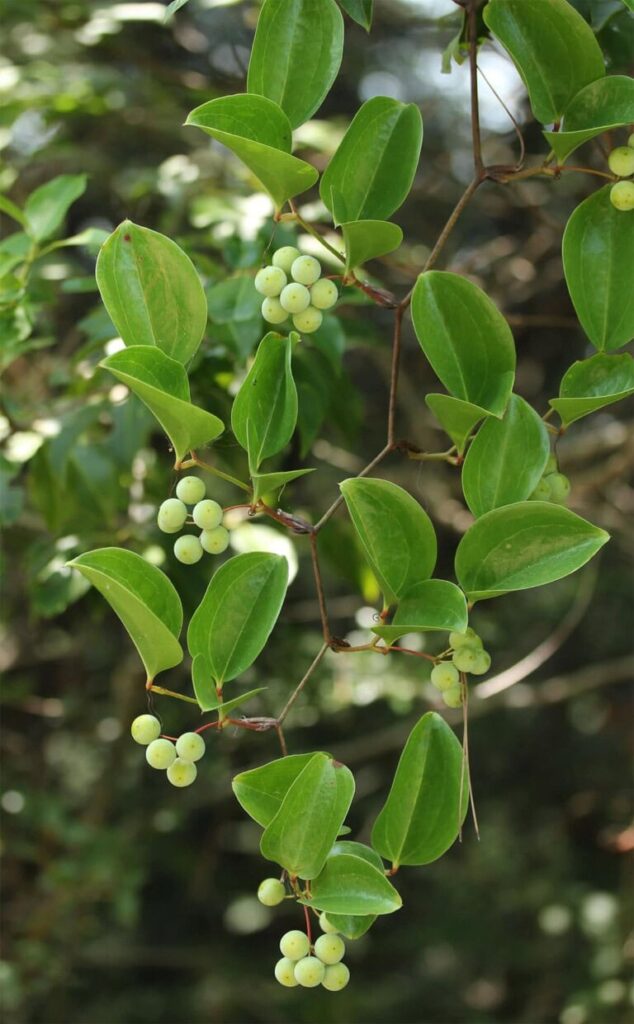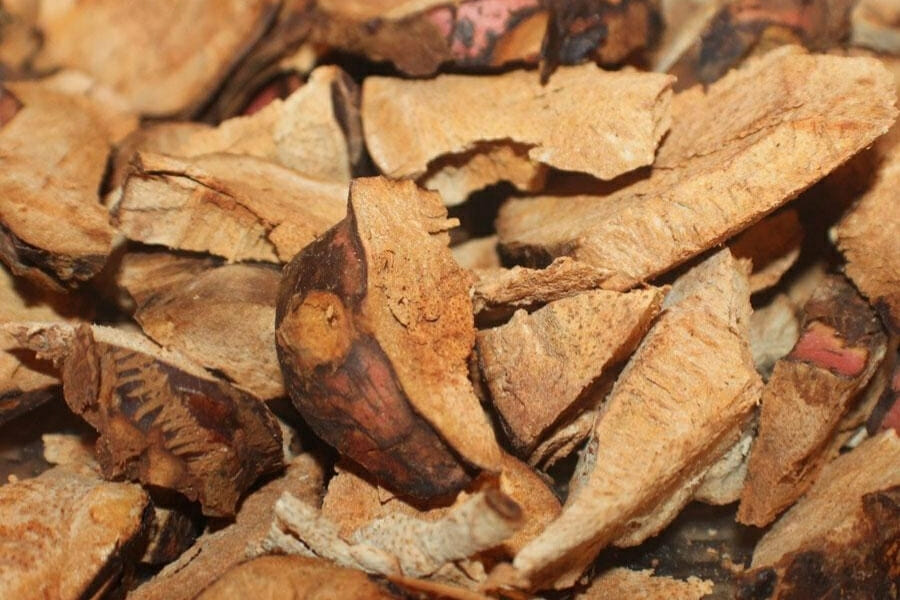Botanical Name:: Primarily Smilax balbisiana, Smilax officinalis, Smilax ornata
Common Names:: Chaney Root, Chaney, Jamaican Sarsaparilla, Iron Root
Plant Family: Smilacaceae
Plant Part Used:: Root
Origin:: Native to the Caribbean, especially Jamaica and parts of Central and South America.
1. Botanical Description
Chaney root comes from climbing, thorny vines found in lush tropical forests. The plant produces long, woody, rope-like roots that twist beneath the soil. The roots are:
- Reddish-brown to dark brown
- Tough, fibrous, slightly aromatic
- Rich in saponins, giving them a faint foaming action when boiled
- Taste: mildly bitter, earthy
It is often confused with Jamaican sarsaparilla (Smilax regelii), and they are from the same family with overlapping benefits. In Jamaica, they are sometimes used together.
2. Key Constituents
Chaney root is nutritionally dense and chemically active. Major constituents include:
• Saponins (steroidal): Support endocrine balance, detoxification, and blood building.
• Iron-rich mineral complexes: Caribbean herbalists prize Chaney root as a natural “iron tonic,” particularly for building strong blood.
• Phytosterols & resin acids: Support hormonal balance and reproductive health.
• Flavonoids & polyphenols: Antioxidant, immune-supporting, anti-inflammatory.
• Volatile oils: Give the plant its characteristic earthy aroma and support circulation.
3. Traditional Uses (Caribbean, African-Diaspora, Central America)
Chaney root is a foundational herb in Afro-Caribbean folk medicine. Traditionally it is used to:
• Build and purify the blood: Used for anaemia, low vitality, weakness, and recovery after illness.
• Support men’s reproductive and sexual health: Included in “roots tonics” for libido, stamina, and hormonal balance.
• Strengthen women’s reproductive system: Used for irregular cycles, cleansing the womb, and postpartum restoration.
• Improve circulation & joint health: Often combined with sarsaparilla, gumbo root, strongback, or dandelion.
• Detoxify the body: Herbalists use it to cleanse the skin, liver, and lymphatic system.
• Support immune resilience: Tonics made with Chaney root are used for chronic fatigue, infections, and general system weakness.

4. Energetic & Herbal Actions
Energetics:
- Warming
- Restorative
- Building (nutritive)
- Slightly drying
- Deeply tonic
Herbal Actions:
- Alterative (blood cleanser)
- Hematinic (blood builder)
- Tonic (general)
- Adaptogenic-like
- Anti-inflammatory
- Reproductive tonic
- Circulatory stimulant
- Mineralising herb
- Mild diuretic
- Endocrine-supporting
Chaney root is not a stimulant in the harsh sense – its “energy boost” comes from improved mineral status, circulation, and oxygenation.
5. Medicinal Benefits (Modern + Traditional Combined)
A. Blood & Circulation
- High iron and saponin content support robust hematopoiesis (blood formation).
- Enhances oxygen delivery to tissues.
- Strengthens weak blood conditions and low energy.
B. Detoxification & Liver Support
- Promotes elimination through the skin, kidneys, and lymph.
- Purifies the bloodstream, traditionally used for skin conditions like rashes, eczema, and acne.
C. Reproductive & Hormonal Health
Men
- Supports testosterone balance
- Helps with stamina, virility, and recovery
- Common in Caribbean tonic formulas with medina, sarsaparilla, and strongback
Women
- Balances cycles
- Strengthens the womb
- Supports fertility
- Traditionally used postpartum for rebuilding blood and energy
D. Joints & Musculoskeletal Health
- Reduces inflammation
- Improves flexibility and circulation
- Used for rheumatism and joint stiffness
E. Immune & Endocrine System
- Enhances resilience against chronic infection
- Supports adrenal stability (stress response)
- Helps with exhaustion and long-term fatigue
6. Dr. Sebi Perspective (Applicable Points)
Although Dr. Sebi did not specifically highlight Chaney root by name as prominently as sarsaparilla or burdock, the herb aligns perfectly with his core principles:
✓ Iron-rich herbs are the foundation of healing: Chaney root is an iron-building plant, which Sebi emphasised as essential for revitalising the blood and oxygen system.
✓ African Bio-Mineral Balance prioritises cellular hydration + electric foods: Chaney root contains natural plant-based minerals that the body absorbs easily.
✓ Detoxification through natural herbs: Its cleansing actions on the liver, lymph, and blood fit directly within Sebi’s detox approach.
✓ Balances reproductive systems without hormonal interference: This is consistent with Sebi’s focus on herbs that regulate the body naturally rather than through synthetic compounds.
Typical Dr. Sebi-Aligned Combinations:
- Chaney Root + Jamaican Sarsaparilla (strong iron tonic)
- Chaney Root + Burdock Root
- Chaney Root + Dandelion Root
- Chaney Root + Yellow Dock (if desired)
7. Preparation Methods
1. Decoction (Traditional Tea)
The most common method.
Ingredients:
- 1-2 tablespoons chopped Chaney root
- 3-4 cups water
Instructions:
Simmer for 20-30 minutes until the water darkens.
Drink ½-1 cup 1-2 times daily.
2. Combination Roots Tonic
Often blended with:
- Sarsaparilla
- Strongback
- Dandelion
- Duan
- Medina
- Puron
- Chaney root
These are boiled together to create a deep red, rich tonic.
3. Long Decoction / “Root Wine” (Traditional Jamaican)
Roots are boiled, then soaked in water for 12-24 hours.
Honey, molasses, or raisins may be added traditionally, though you may omit if following Sebi-inspired guidelines.
4. Powder / Capsules
Less traditional but convenient.
Typical use:
500-1000 mg per dosage, once or twice daily.
8. Safety, Contraindications & Cautions
Chaney root is generally safe and well-tolerated when used traditionally, but:
Avoid or use caution if:
- Pregnant (strong blood-moving herb)
- On diuretics
- On medications processed by the liver
- You have very low blood pressure
- You have kidney disease (due to mineral load)
Mild detox reactions may occur:
- Light headaches
- Skin cleansing (temporary breakouts)
- Mild digestive loosening
These usually pass as the body adjusts.
9. Botanical Notes & Mis-identification Issues
- Chaney root is often confused with or sold interchangeably with Jamaican sarsaparilla.
- True Chaney root tends to be lighter, more flexible, and less bitter than strong sarsaparilla.
- Both are Smilax species, but each has slightly different profiles.
Most herbalists blend them for a broader tonic effect.
10. Summary
Chaney root is a powerful Caribbean iron-building blood tonic with centuries of use behind it. It supports the:
- Blood
- Liver
- Hormones
- Reproductive systems
- Immune system
- Circulation
- Skin
- Joints
In Afro-Caribbean herbal tradition, it is regarded as a foundation herb for vitality, stamina, and purification.
Its synergy with Jamaican sarsaparilla, burdock, yellow dock, and dandelion makes it one of the most complete traditional blood and energy tonics available.
References For Chaney Root
Scientific & Botanical References
- Sharma, A., & Sharma, V. (2020). Phytochemical and pharmacological profile of Smilax species: A comprehensive review. Journal of Ethnopharmacology.
– Review covering chemistry (saponins, flavonoids), traditional uses, and medicinal actions. - World Flora Online (WFO). Smilax balbisiana; Smilax officinalis; Smilax ornata.
– Botanical classification, geographic distribution, and species distinctions. - Hooker, J. D. (1875). Flora of the British West Indies.
– Early botanical descriptions of Smilax species used in the Caribbean. - Kumar, S., et al. (2012). Steroidal saponins from Smilax species. Natural Product Research.
– Details chemical compounds relevant to blood-building and endocrine support.
Pharmacology & Constituents
- Harborne, J. B. (1998). Phytochemical Methods: A Guide to Modern Techniques of Plant Analysis.
– Provides methodology and phytochemical identification commonly applied to Smilax roots. - Ramalho, L. S., et al. (2001). Chemical characterization of Smilax officinalis root. Phytochemistry.
– Outlines saponins, minerals, and sterols found in sarsaparilla-type roots. - Chou, T. (2002). Antioxidant properties of Smilax extracts. Journal of Medicinal Plants Research.
– Demonstrates anti-inflammatory, antioxidant actions similar to Chaney root.
Ethnobotanical & Traditional Use
- Honychurch, L. (1980). Caribbean Wild Plants and Their Uses.
– Records traditional uses of Chaney root and related Smilax species. - Asprey, G. F., & Thornton, P. (1953). Medicinal plants of Jamaica. West Indian Medical Journal.
– Describes Chaney root and other tonic herbs used in Jamaican folk medicine. - Robinson, R. (1997). The Roots of Jamaican Herbalism.
– Covers roots tonics, traditional preparation, and cultural applications. - Wong, W. (1976). Some Folk Medicinal Plants from Trinidad.
– Includes Smilax species used for “blood cleansing,” reproductive health, and stamina.
Mineral & Nutritional Content References
- Institute of Nutrition of Central America and Panama (INCAP). Documentation on mineral-rich wild roots.
– Provides mineral analysis frameworks applied to herbs like Smilax. - Duke, J. A. (2002). Handbook of Medicinal Herbs.
– Lists actions: alterative, tonic, anti-inflammatory, endocrine-supporting.
West African & African Diaspora Context
- Fennell, C. W., et al. (2004). The use of African medicinal plants in the Caribbean. Journal of Ethnobiology.
– Explores plant migration, African influence, and traditional root herbalism practices.
This article is copyrighted by Ital is Vital, 2025. Want to re-post this article? Visit our guidelines.
DISCLAIMER: THIS WEBSITE DOES NOT PROVIDE MEDICAL ADVICE
The information, including but not limited to, text, graphics, images and other material contained on this website are for informational purposes only. The purpose of this website is to promote broad consumer understanding and knowledge of various health topics. It is not intended to be a substitute for professional medical advice, diagnosis or treatment. Always seek the advice of your physician or other qualified health care provider with any questions you may have regarding a medical condition or treatment and before undertaking a new health care regimen, and never disregard professional medical advice or delay in seeking it because of something you have read on this website.
